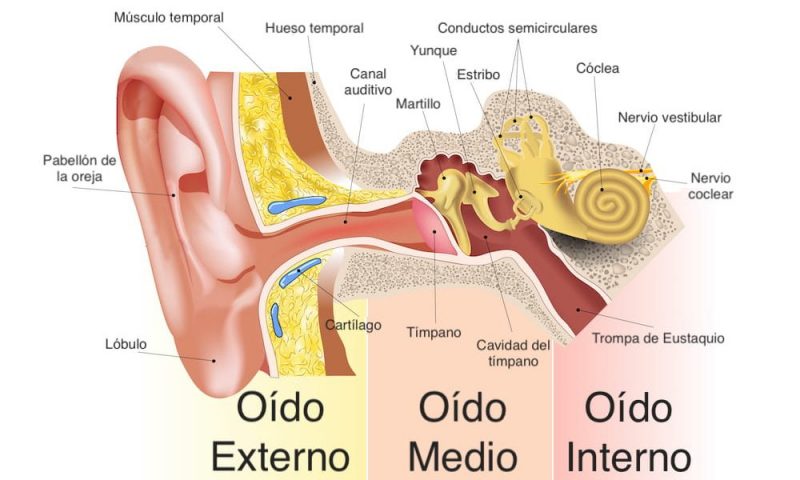We explain what the sense of hearing is, how hearing works and the anatomy of the ear. Also, how you can take care of your hearing.

What is the sense of hearing?
The sense of hearing or hearing is one of the five senses through which humans and animals perceive the surrounding reality. The hearing depends on the organ of hearing, capable of capturing sound vibrations in the air around it that oscillate between 20 and 20,000 hertz (Hz), that is, an immense range of differentiated sounds, which are classified based on a logarithmic scale of pressures (decibels).
In simple terms, hearing is perceiving the vibrations that a body or reaction triggers in the air around us. This process can also occur in other transmission media, such as water, although the properties of the medium alter the transmission and perception of sound waves.
Hearing, furthermore, is a passive sense, difficult to control or suppress without the help of external implements. Its function in humans and animals is to alert about the presence of what is happening around, at a healthy distance that allows the individual to prepare for a possible threat.
It also allows animals to call to each other, respond to mating invitations, or even intimidate competitors, which is why animals often growl or make threatening noises. That is to say, It is very useful for communication.
In humans, furthermore, hearing is necessary for the main and most effective communication mechanism of the species, which is speech, and without it the possibilities of social exchange and free interaction of individuals in society are significantly reduced.
How does hearing work?
Hearing is a complex process, which involves both external elements and physiological processes of the body, throughout two auditory systems:
- Peripheral: It is the ear that captures sounds.
- Central: It is the nervous system that interprets them.
The starting point, logically, is the production of sound waves by some phenomenon in reality, and their transmission through the air to the external pinnae of the ears, which operate as sound reception antennas conducting sound waves inside, through the ear canal.
sound waves thus they reach the eardrum which is a flexible membrane capable of vibrating according to the perceived sound. This is how it is transmitted to a chain of ossicles that amplify it and transmit it to the inner ear, through the oval window.
Finally, sound mobilizes the liquids contained in the cochlea (called perilymph and endolymph) and also the hair cells inside, responsible for transform the perceived vibration into nervous information which is sent to the brain through the auditory nerve.
Finally, nervous information It is picked up by the primary auditory cortex of the temporal lobe of the brain where it is processed and shared with the rest of the brain to produce an appropriate reaction.
ear anatomy

The ear is a complex organ that is responsible not only for perceiving sound, but also for the sense of balance. To study it, it can be divided into three different sections, which are:
external ear. The portion of the ear that is on the surface of the body, and that includes two parts:
- The pavilion of the ear formed by cartilage and covered with skin, located on both sides of the head.
- The ear canal about 2.5 cm in length, which connects the pinna with the eardrum, passing through the temporal bone of the skull. There are also villi and cerumen-producing glands, whose mission is to stop the advance of foreign bodies.
middle ear. It is an internal cavity filled with air, separated from the external auditory canal by the eardrum, and at the same time communicated with the inner ear through two small openings: the oval window and the round window.
- The eardrum It is a transparent oval-shaped membrane of around 1 cm. in diameter, formed by elastic collagen fibers. Inside the tympanic cavity are the smallest bones in the body: a chain of articulated bones known as the malleus, stapes and incus, whose role is to transform air vibrations into vibrations of the fluids of the inner ear.
- The Eustachian tube It is a tube-shaped structure, located in the lower region of the same cavity, that connects the middle ear with the rhinopharynx, allowing pressures to be balanced on both sides of the eardrum.
inner ear. Also known as the “labyrinth”, it is located within the temporal bone of the skull, and is made up of a bony part and a membranous part. The first covers the second and the latter is made up of a system of hollow ducts. Here the inner ear is divided into two very different portions: the semicircular canals and the vestibule, intended to preserve the individual's balance, and the cochlea or snail, which is spiral-shaped and is dedicated to transmitting sound to the nervous system. The latter is also divided into three parts:
- The vestibular ramp which ends at the oval window and is filled with a fluid called perilymph.
- The scala tympani which ends in the round window and is also filled with perilymph.
- The middle ramp also known as the cochlear duct, is filled with another fluid called endolymph, and inside it is the organ of Corti, a structure composed of auditory sensory cells (hair cells), which perceive the mechanical energy of the vibrations of the endolymph and They transform them into nervous impulses, which flow through the branches of the auditory nerve with which they come into contact.
Ear care
Hearing and ear care are relatively simple, and can be summarized as follows:
- Avoid exposure to excessively intense noises or at very high volume, both in the usual environment and while using headphones.
- Do not insert objects into the ear canal not even to clean it. Earwax fulfills natural defense roles and only the excess found in the outermost portions of the ear should be removed.
- Maintain regular hygiene of the pinna of the ears and avoid introducing toxic, irritating or any other substances into the ear canal.
- Use hearing protection when exposure to intense noise is unavoidable, especially for long periods.
- Visit the doctor in case of hearing disorders or ailments of any kind. Ear infections can be a source of hearing loss.
Continue with: Sense of smell
References
- “Overheard” on Wikipedia.
- “Audition” on Wikipedia.
- “Functioning of the ear” in RDR (Mexico).
- “Video describing the Hearing Process and How it works” (video) in MED-EL.
- “Anatomy and Physiology of the Ear” at Stanford Children's Health.





